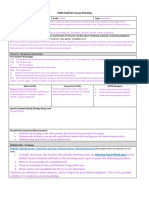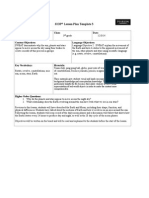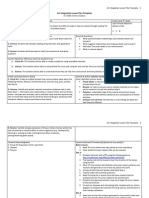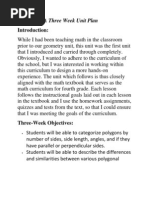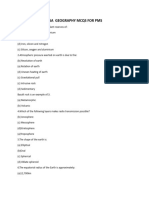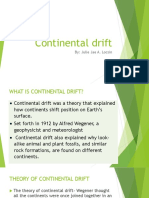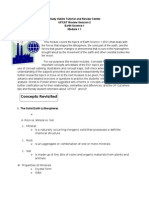EDRD 6150 Lesson Plan Form 3
EDRD 6150 Lesson Plan Form 3
Uploaded by
Tiandra CantyCopyright:
Available Formats
EDRD 6150 Lesson Plan Form 3
EDRD 6150 Lesson Plan Form 3
Uploaded by
Tiandra CantyCopyright
Available Formats
Share this document
Did you find this document useful?
Is this content inappropriate?
Copyright:
Available Formats
EDRD 6150 Lesson Plan Form 3
EDRD 6150 Lesson Plan Form 3
Uploaded by
Tiandra CantyCopyright:
Available Formats
EDRD 6150 Lesson Plan- 3
Your Name: Tiandra Harris-Canty_
Standard:
S6E5 a. Ask questions to compare and contrast the Earth’s crust, mantle, inner and outer core,
including temperature, density, thickness, and composition.
S6E5 f. Construct an explanation of how the movement of lithospheric plates, called plate
tectonics, can cause major geologic events such as earthquakes and volcanic eruptions.
(Clarification statement: Include convergent, divergent, and transform boundaries.)
Objective(s):
Students will be able to explain the function of the lithosphere and asthenosphere.
Students will be able to explain how scientific theories develop, specifically the theory of
plate tectonics.
Students will be able to describe tectonic plates and how they cause Earth to move.
Students will be able to identify and explain geologic events that occur at fault lines.
Specific Literacy Strategy or Strategies (Name and describe how you used the strategy.)
Paired Reading- Students will be paired on Lexile to complete the reading. Students who
need the extra support will have the option of using the audiobook.
Annotation- Students will annotation as they complete the reading. They will circle any
keywords (especially those that will be used in the Frayer model), write comments or
questions on the margin, underline the answer to the questions, and highlight any word
that they need help with.
Graphic Organizer: Frayer Model- this model will be used to help students clarify the
meaning of some of the words they will encounter in this standard. After the reading,
teacher will give students the four words that are important to the text and the standard.
Students will also have the opportunity to include a word they may need help with. They
will include the definition, characteristics, example, and image for each word.
Hook/Introduction (15 minutes):
Lesson will begin by stating the objectives of the class.
Teacher will continue with posing the question
o “How do we know what’s under the Earth?”
o “How does the Earth move?”
o “What is the name of the sub-layer that is s a combination of the upper mantle and
crust? What is its function?”
o Do you think the Earth has always look how it looks now?
Teacher will transition questions to present the discussion storyboard to the student by
projecting on the broad.
Students will be given 4 minutes to select who they think is correct and explain why?
Teacher will explain who geologist are and post the definition on the board. Teacher will
also reveal the answer to the discussion story board and link this to the standard that will
be covered, lithospheric plates/plate boundaries.
Step By Step Methods:
Group Activity (10 minutes)
Students will be given a copy of the continents. They will work in pairs to name each
continent and write the names on each continent.
Teacher will monitor and review the name of the continents.
Students will color and cut out the continents along the dotted lines and line them up how
they would appear on a world map. (they will have to make sure that the fossil clues are
color the same color.
Students will try to arrange the continents so that they fit together like a puzzle.
Class Discussion (5 minutes)
What are some things that you notice when putting the “puzzle” together?
Teacher will explain what Pangaea, Alfred Wegner and his evidence.
Students will be shown a map or Pangaea, the supercontinent, to compare how close they
were at putting the puzzle together.
Independent Activity (20 minutes)
Students will read and annotate the passage on Pangaea using Read Works.
Students will complete the Frayers Model for the following vocabulary based on today’s
activity (if not complete in class, must be completed as homework).
o Pangaea, Continental drift, Plates, Evidence
Closing (5 minutes):
Reflection
Students will think about what they learned and how it relates to today. They will be
asked the following questions:
o Do you think the tectonic plates are still moving today?
o What do you think caused them to move?
Assessment:
Discussion storyboard, questions to the passage
Materials Needed:
Discussion Storyboard, copy of continents for each student, coloring utensils, Scissors,
world map, Read Works Pangaea Passage, highlighter, Projected copy of Frayer Model
You might also like
- Volcano Lesson Plan Grade 9Document4 pagesVolcano Lesson Plan Grade 9Erica De Vera89% (18)
- 101 EFL Activities for Teaching University StudentsFrom Everand101 EFL Activities for Teaching University StudentsRating: 4 out of 5 stars4/5 (3)
- Math 5e Lesson Planning Template Spring 2021Document9 pagesMath 5e Lesson Planning Template Spring 2021api-457377507No ratings yet
- Concept Attainment LessonDocument5 pagesConcept Attainment LessonMariah McKinnon100% (4)
- Earths Interior Lesson PlanDocument4 pagesEarths Interior Lesson Planapi-26453381875% (4)
- Landforms Lesson Plan - Completed VersionDocument7 pagesLandforms Lesson Plan - Completed Versionapi-364942122No ratings yet
- Siop Lesson Plan Day 1Document3 pagesSiop Lesson Plan Day 1api-273275279No ratings yet
- Diorite and BasaltDocument16 pagesDiorite and BasaltKyubi Nine100% (1)
- Lab01 GeoworldDocument15 pagesLab01 GeoworldKaren Melina Zapata ParedesNo ratings yet
- EDRD 6150 Lesson Plan Form2Document3 pagesEDRD 6150 Lesson Plan Form2Tiandra CantyNo ratings yet
- Layers of The Earth Lesson PlanDocument3 pagesLayers of The Earth Lesson Planapi-240608311No ratings yet
- Lesson 2Document4 pagesLesson 2api-297076449No ratings yet
- Earth & Life Science LPDocument15 pagesEarth & Life Science LPAileen gay PayunanNo ratings yet
- Lessonplan 1Document2 pagesLessonplan 1api-240859589No ratings yet
- Scale Realms UniverseDocument11 pagesScale Realms Universelahsivlahsiv684No ratings yet
- 4th Grade Layers of The Earth Lesson Plan - EllDocument5 pages4th Grade Layers of The Earth Lesson Plan - Ellapi-748615628No ratings yet
- Science Lesson For ElDocument3 pagesScience Lesson For Elapi-279742832No ratings yet
- Mini-Science UnitDocument24 pagesMini-Science Unitapi-287048666No ratings yet
- Lessonplan Latitude and LongitudeDocument3 pagesLessonplan Latitude and Longitudeapi-338929411100% (5)
- Solar System Lesson PlanDocument5 pagesSolar System Lesson PlanKayla RhodesNo ratings yet
- Astronomy Unit PlanDocument17 pagesAstronomy Unit PlanMariah McKinnonNo ratings yet
- Revised Reset 6th Grade Unit Layout and Materials 4 1 24Document11 pagesRevised Reset 6th Grade Unit Layout and Materials 4 1 24api-735929865No ratings yet
- Unit 2 Lesson 3Document3 pagesUnit 2 Lesson 3api-240273723No ratings yet
- Stratigraphic Maps - Lesson Plan 3Document5 pagesStratigraphic Maps - Lesson Plan 3hannahtubbs001No ratings yet
- Teacher: Mr. Seth Kurzynski Grade Level: 9 Course: Geometry Unit: Area Essential QuestionsDocument27 pagesTeacher: Mr. Seth Kurzynski Grade Level: 9 Course: Geometry Unit: Area Essential Questionsapi-593931076No ratings yet
- Lesson Plan: Valerie ChavezDocument2 pagesLesson Plan: Valerie Chavezapi-498266218No ratings yet
- LP 2Document3 pagesLP 2api-240859589No ratings yet
- Esol Unit PlanDocument24 pagesEsol Unit Planapi-237195020No ratings yet
- Indiana Wesleyan University Elementary Education Lesson PlanDocument5 pagesIndiana Wesleyan University Elementary Education Lesson Planapi-350000132No ratings yet
- Triangles Lesson PlanDocument5 pagesTriangles Lesson PlanalyssamanningNo ratings yet
- Main Lesson AimsDocument4 pagesMain Lesson Aimsapi-245632465No ratings yet
- Social Stud WeebDocument2 pagesSocial Stud Weebapi-240110497No ratings yet
- Anisa Saigo Lesson Plan Earth ScienceDocument5 pagesAnisa Saigo Lesson Plan Earth ScienceAnisa SaigoNo ratings yet
- Educ 414 - 6e Lesson 2Document5 pagesEduc 414 - 6e Lesson 2api-489586313No ratings yet
- EDUC 2220-Educational Technology Lesson Plan: Common Core StandardsDocument6 pagesEDUC 2220-Educational Technology Lesson Plan: Common Core StandardsJessica FunkNo ratings yet
- Lesson 1Document4 pagesLesson 1api-241112979No ratings yet
- DLP 24Document2 pagesDLP 24Vanda RemaNo ratings yet
- Cave Bulletin BoardDocument2 pagesCave Bulletin Boardapi-209844354No ratings yet
- Grade Level 10 - Lesson Plan CO1Document3 pagesGrade Level 10 - Lesson Plan CO1Arnold S DumapatNo ratings yet
- Mikula Tect Boundary 4 LDocument3 pagesMikula Tect Boundary 4 Lapi-710735237No ratings yet
- Dynamic Crust Intro LessonDocument7 pagesDynamic Crust Intro Lessonjdanf001No ratings yet
- Q1 Week 2Document11 pagesQ1 Week 2CHERAMAE MORALESNo ratings yet
- Residential Schools - Lesson PlanDocument8 pagesResidential Schools - Lesson Planapi-344048182No ratings yet
- Ê Ê Êtessellation Insights Ê Ê 8 Ê Mathematics Ê Êcaitlin Lynchêê Êgeometry/Anglesê ÊDocument6 pagesÊ Ê Êtessellation Insights Ê Ê 8 Ê Mathematics Ê Êcaitlin Lynchêê Êgeometry/Anglesê Êcaitlynch928No ratings yet
- Lesson Plan SpeakingDocument5 pagesLesson Plan Speakingqvdrfwjv5mNo ratings yet
- EarthscienceEarth's Layers Lesson Plan 6th GradeDocument2 pagesEarthscienceEarth's Layers Lesson Plan 6th Gradeeliza s. crusperoNo ratings yet
- EDU 325 - Group Lesson PlanDocument8 pagesEDU 325 - Group Lesson Plandrd92No ratings yet
- Creation of The Earth-Lesson Plan 1Document6 pagesCreation of The Earth-Lesson Plan 1hannahtubbs001No ratings yet
- Esol Unit PlanDocument24 pagesEsol Unit Planapi-254772783No ratings yet
- LP 3Document3 pagesLP 3api-240859589No ratings yet
- UBD Earth and Travel Unit Plan 7.18Document3 pagesUBD Earth and Travel Unit Plan 7.18Etika RamadaniNo ratings yet
- Up3 ss15 Justus RobertsDocument6 pagesUp3 ss15 Justus Robertsapi-290860053No ratings yet
- Imb Final ScienceDocument11 pagesImb Final Scienceapi-296618130No ratings yet
- Lesson Plan Metaphorical ExpressionDocument4 pagesLesson Plan Metaphorical Expressionapi-335464934No ratings yet
- Maps Lesson PlanDocument8 pagesMaps Lesson Planapi-364942122100% (2)
- Mystery Piece LPDocument2 pagesMystery Piece LPapi-272005587No ratings yet
- Art Integrated Lesson PlanDocument5 pagesArt Integrated Lesson Planapi-248641854100% (1)
- CFPP4 Classroom Planning Ezequiel HaritzhandyDocument43 pagesCFPP4 Classroom Planning Ezequiel HaritzhandyEquipo didácticoNo ratings yet
- Backwards Design Lesson PlanDocument4 pagesBackwards Design Lesson Planapi-202493219No ratings yet
- A Polygon Is Traditionally ADocument9 pagesA Polygon Is Traditionally AKirtikar SukulNo ratings yet
- LP 5Document3 pagesLP 5api-240859589No ratings yet
- My Technology Lesson PlanDocument6 pagesMy Technology Lesson PlanJosh WestlingNo ratings yet
- SciencelessonplanDocument7 pagesSciencelessonplanapi-288669283No ratings yet
- Science10 - q1 - Clas8-Plate - Tectonics - Evidences - of - Plate - Movement-V2 - RHEA ANN NAVILLADocument14 pagesScience10 - q1 - Clas8-Plate - Tectonics - Evidences - of - Plate - Movement-V2 - RHEA ANN NAVILLASophia Erika LargoNo ratings yet
- Giant Impact Origin For The Large Low Shear Velocity ProvincesDocument2 pagesGiant Impact Origin For The Large Low Shear Velocity ProvincesZerohedge100% (1)
- RIVERA LyssaJean Threshold04Document6 pagesRIVERA LyssaJean Threshold04LYSSA JEAN RIVERANo ratings yet
- DK Find Out - EarthDocument66 pagesDK Find Out - Earthphanlena100% (5)
- PreCm Geology of Finland - Lehtinen Et Al - 2005 - BOOK PDFDocument751 pagesPreCm Geology of Finland - Lehtinen Et Al - 2005 - BOOK PDFLubomira MachevaNo ratings yet
- Unit 2: Geologic Hazards and DisastersDocument23 pagesUnit 2: Geologic Hazards and DisastersJBNo ratings yet
- Groves, D. and Bierlein, F. (2007)Document12 pagesGroves, D. and Bierlein, F. (2007)WilliamsRafaelMataRimac100% (1)
- The Geology of PapuaDocument9 pagesThe Geology of PapuaarkoesteaNo ratings yet
- Earthlayers 100505153531 Phpapp02Document17 pagesEarthlayers 100505153531 Phpapp02Kru FarNo ratings yet
- Plate TectonicsDocument13 pagesPlate Tectonicsburychurch100% (20)
- Grade 11 Geography Textbook in Sinhala Medium - New SyllabusDocument166 pagesGrade 11 Geography Textbook in Sinhala Medium - New SyllabusAshen Vidarshana100% (2)
- RocksDocument29 pagesRocksMohd Hafiez HamidNo ratings yet
- MCQDocument53 pagesMCQPawanNo ratings yet
- Active VolcanoesDocument7 pagesActive VolcanoesMargie Torregosa-Sabunod ValdonNo ratings yet
- About Bardon Hill QuarryDocument3 pagesAbout Bardon Hill QuarryRafael Ernesto Sánchez SuárezNo ratings yet
- GSA Geography Mcqs For PMSDocument10 pagesGSA Geography Mcqs For PMSzunorainirfan001No ratings yet
- Earth Internal Heat SourceDocument21 pagesEarth Internal Heat SourceRickyNo ratings yet
- 1st Quarter DLP in Science 10Document27 pages1st Quarter DLP in Science 10VineNo ratings yet
- Sci10 Q1 Module2Document29 pagesSci10 Q1 Module2spencerNo ratings yet
- Geology Test Bank First Semester G.12Document63 pagesGeology Test Bank First Semester G.12mohamed abdullaNo ratings yet
- Geography Notes 2Document52 pagesGeography Notes 2ayan mitraNo ratings yet
- Continental DriftDocument15 pagesContinental DriftAndrea BaluyotNo ratings yet
- Geology, A Complete IntroduvvDocument400 pagesGeology, A Complete IntroduvvEdward ChirinosNo ratings yet
- MagmatismDocument15 pagesMagmatismjadenn busiaNo ratings yet
- ELS SHS Unit 5 Compositional Layers of Earth Study GuideDocument45 pagesELS SHS Unit 5 Compositional Layers of Earth Study GuidemyccahannalapasaranNo ratings yet
- Indian PlateDocument4 pagesIndian Platenosferatu jodNo ratings yet
- UPCAt Earth Science Module 1Document14 pagesUPCAt Earth Science Module 1fodavila50% (2)


